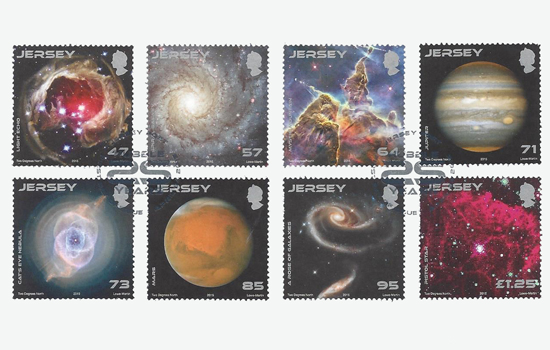Pistol Star gets a stamp of approval
RIT’s Don Figer imaged star with Hubble as a young astronomer at UCLA
A set of British postal stamps commemorating the 25th anniversary of NASA’s Hubble Space Telescope includes a star detected by RIT Professor Don Figer nearly 20 years ago. The Pistol Star stamp is featured at the bottom right corner.
A set of British postal stamps commemorating the 25th anniversary of NASA’s Hubble Space Telescope includes a star detected by a Rochester Institute of Technology professor nearly 20 years ago.
The Pistol Star made international news in 1997 and continues to shape Don Figer’s career in unexpected ways. Most recently, an employee at the Jersey Post in the United Kingdom called Figer seeking permission to put the Pistol Star on a stamp.
“The call took me by surprise,” said Figer, professor of physics and director of the Center for Detectors at RIT. “It was a nice courtesy, but the Hubble pictures aren’t mine.”
Figer doesn’t own copyright to the image he helped make famous. Hubble’s pictures are in the public domain and are free to use.
The Pistol Star is considered to be one of the most luminous, massive young stars in the Milky Way. It is part of the Quintuplet Cluster near the galactic center and takes its name from the Pistol Nebula, a dying star, whose gas was ejected from and now surrounds the star. Figer had recently earned his Ph.D. in astronomy at the University of California at Los Angeles when he released the Hubble image of this bright, young star on Oct. 8, 1997.
News of the massive young star with the evocative name went viral, 1990s style. It landed Figer on the front page of the New York Times, above the fold, and on the ABC Nightly News.
The Pistol Star quickly found a place in pop culture. Figer remembers a Los Angeles-based band, Mary’s Danish, whose lead singer went on to form a new band named Pistol Star. The name caught on in other circles and has resurfaced on T-shirts, tattoos and Twitter. Pistol Star is also the name of clothing line and a thoroughbred racehorse in Australia.
Figer never anticipated the Pistol Star’s broad appeal.
“Sometimes, you do something in science and it becomes a popular cult thing,” he said.
Since the Pistol Star, Figer has balanced his research between observing massive star clusters and other astronomical objects, and advancing imaging detectors for industry and astronomy. But the Pistol Star keeps popping up in unusual places—this time in the mail.














